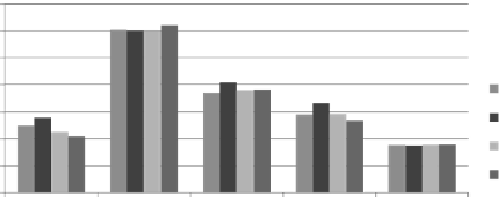Information Technology Reference
In-Depth Information
14
12
10
8
2011
2009
2007
2005
6
4
2
0
Privacy/
security
Usability
Content
Service
Citizen
participation
Figure 2.2 Average score by categories 2005-2011. (From Holzer, M., &
Manoharan, A. (2012).
Digital governance in municipalities worldwide (2011-
2012)
. newark, nJ: e-Governance institute, Rutgers University.)
This study has some limitations. To begin with, the survey includes only
100 municipalities in selected countries, a limited sample in terms of reflecting
e-governance developments at the municipal level worldwide. In addition, the
largest municipality in each country may not represent all municipalities in
a country. The study focuses only on a municipality's official website, explor-
ing government performance in providing e-governance services and engaging
citizens. However, although the data for each were collected from a user's per-
spective, the study may not fully address users' experiences and provide limited
information about public usage (width and depth) toward e-governance. In addi-
tion, examining only digital tools used via government websites is limited in
terms of reflecting the entire e-governance level. For example, in the category
citizen and social engagement, whether governments provide convenient ways for
citizens to interact with governments is examined; however, citizen participation
is more potentially more extensive. Whether and how governments make use of
public feedback and engage citizens in policy making processes in a meaningful
way also need to be tested.
2.6 Best Practices in e-Governance
Best practices are common in many disciplines. Exploring best practices is impor-
tant because these municipalities provide excellent examples for others to learn.
Similarly, e-governance needs to identify best practices as well, for better under-
standing e-governance and its achievement. In this study, on the basis of the
2011-2012 digital governance survey data, we select municipalities ranking high
in various categories and use detailed examples to describe their performance in
privacy and security, usability, content, services, and social engagement, thus con-
tributing to a better understanding of good e-governance.

Search WWH ::

Custom Search